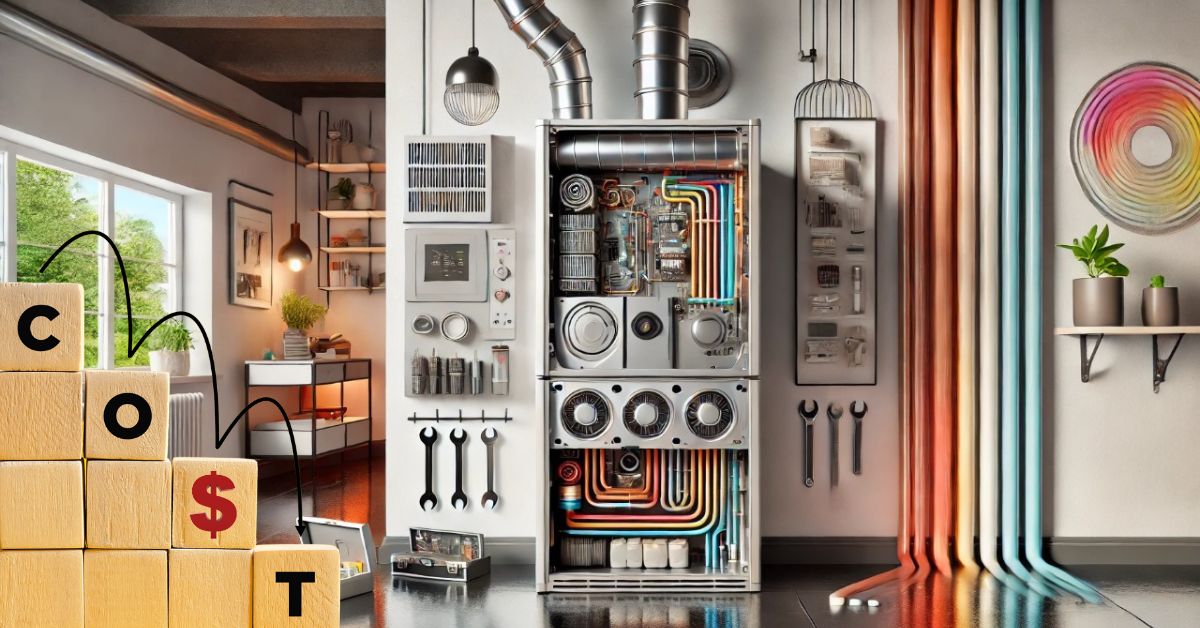A furnace is essential in ensuring a comfortable and energy-efficient home or commercial space. However, the process is more complex than just purchasing and plugging a stove. Factors like furnace type, size, and installation labor can significantly affect the cost. This guide explains the key elements that influence furnace installation expenses and provides insight into the different types of furnaces available.
Average Furnace Installation Cost
The cost to install a furnace typically ranges between $2,500 and $6,500, depending on the size of the unit and other variables. In addition to the unit itself, labor costs for installation generally run between $150 and $500 per hour. It’s important to note that these figures are for new installations, not repairs or upgrades to an existing furnace.
The size of a furnace is measured in British Thermal Units (BTUs), which indicate its heat output. Homeowners typically require 30 to 50 BTUs per square foot of living space. For instance, an 80,000 BTU furnace is ideal for a 2,000-square-foot home. The type of furnace you choose will also majorly impact the cost.
Types of Furnaces and Their Costs
Electric Furnace
Electric furnaces are priced between $800 and $1,100 for the unit alone, with the total installation cost ranging from $2,000 to $4,000. Electric furnaces are often the most energy-efficient option because they use electricity to generate heat. While electric bills might be higher, these furnaces are easier to install and maintain.
Natural Gas Furnace
Natural gas furnaces are a popular choice, costing $700 to $3,000 for the unit or $3,000 to $8,000 with installation. If you’re replacing an electric furnace with a gas one, expect an additional $200 to $500 for gas line installation. Gas furnaces are known for their lower annual operational costs and eco-friendliness than oil or propane options.
Oil Furnace
Oil furnaces cost between $600 and $2,500 for the unit or $3,000 to $5,000 with installation. These furnaces spray oil into a combustion chamber, igniting it to produce heat. Although oil furnaces produce maximum heat, they have higher fuel costs than natural gas ones.
Propane Furnace
Propane furnaces are priced at $800 to $2,000, with installation costs between $2,000 and $5,000. They are an excellent alternative for homes without access to natural gas but require a propane tank installation. The cost of operating a propane furnace varies based on efficiency and local propane gas prices.
Additional Factors That Affect Furnace Installation Costs
Several factors beyond just the price of the furnace and labor affect the total cost of installation:
Brand
Furnace prices vary based on the brand. Well-known brands like Lennox and American Standard typically charge more, but they offer higher quality and more excellent durability. High-efficiency models from these brands may cost more upfront but save money on fuel costs in the long term.
Efficiency
A furnace’s efficiency is measured by its Annual Fuel Utilization Efficiency (AFUE) rating. Furnaces with a higher AFUE rating use more energy for heating rather than losing it. For instance, a stove with a 90% AFUE rating means that 90% of the energy is converted into heat, while 10% is lost. High-efficiency furnaces tend to cost more initially but lead to lower energy bills.
Ongoing Maintenance Costs
In addition to the initial installation cost, furnaces require ongoing maintenance. Routine tasks include changing the air filter every one to three months and scheduling yearly maintenance checks. These steps help prevent breakdowns and extend the lifespan of the furnace. Furnace tune-ups typically cost between $100 and $125, and air filters range from $5 to $30 each.
Size of the Furnace
The size of the furnace is crucial for its performance. The stove won’t heat your space adequately if it is too small. On the other hand, an oversized furnace may lead to short cycling, where the unit turns on and off frequently, causing inefficiency and wear. An HVAC technician will assess your home’s needs to determine the proper furnace size.
Furnace Size and BTU Requirements
Below is a helpful guide for determining the furnace size needed for homes of various sizes:
| Square Footage | Furnace BTUs |
| 700–1,500 sq. ft. | 40,000–60,000 |
| 1,300–3,000 sq. ft. | 80,000–100,000 |
| 1,600–4,000 sq. ft. | 100,000–125,000 |
| 2,000–5,000 sq. ft. | 125,000–150,000 |
A professional will measure the space, considering insulation, window quality, and other factors, to determine the right size for your furnace.
Warranty and Furnace Repairs
Most furnaces come with a manufacturer’s warranty, typically lasting about 10 years. Some installation companies also offer labor warranties, providing added protection. Regular maintenance and following the manufacturer’s guidelines are required to keep the warranty valid.
Furnace repairs are a more affordable alternative to replacing a unit. Typical repairs include cleaning the furnace ($60–$80), replacing a blower belt ($30–$110), or fixing a thermostat ($100–$500). Major repairs, like fixing a cracked heat exchanger, may cost up to $3,500, but the need for such repairs can often be avoided with regular maintenance.
Conclusion: Investing in Furnace Installation
A properly installed furnace has provided warmth, comfort, and energy savings for years. While the upfront cost might seem significant, choosing the right type of furnace, maintaining it properly, and investing in energy-efficient models can help save money in the long run. A qualified HVAC professional is essential for ensuring the installation is done correctly, minimizing the chances of future problems and maximizing your investment.
Related: How Furnaces Work: A Comprehensive Guide
FAQs
How much does it cost to install a new furnace?
The cost of installing a new furnace ranges between $2,500 and $6,500, depending on the type and size of the furnace.
What size furnace do I need for my home?
The square footage of your home determines the size of the furnace. For example, a 2,000-square-foot home typically requires a furnace with 80,000 to 100,000 BTUs.
Are electric furnaces more expensive to run than gas furnaces?
Yes, while electric furnaces are easier to install and maintain, their operating costs are typically higher due to electricity rates.
How often should I replace my furnace filter?
It’s recommended to replace or clean the furnace filter every 1 to 3 months, especially during heavy-use periods in winter.
How long do furnaces typically last?
A well-maintained furnace can last between 15 and 20 years. Regular maintenance can extend its lifespan and improve its efficiency.

